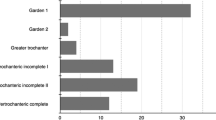Abstract
Background
Neck of femur fractures is the most common fractures associated with low-velocity injury in the elderly. Some patients may require further histological examination of the femoral head due clinical suspicion of malignance as a cause of fracture.
Objectives
To review whether standard screening question(s) could be used to identify patients that require histological examinations following neck of femur fracture.
Study design and methods
Femoral heads sent for histological examination over a period of 5 years were identified from hospital database. All patients presenting acutely with neck of femur fracture above the age of 70 were included, and their case notes were retrospectively reviewed. Reason for histopathological examination were categorised into three screening questions: (Q1) clinical suspicion based on history alone, i.e. neck of femur fracture with no clear history of fall or trauma or preceding hip pain, (Q2) radiological evidence of suspicious abnormality on admission radiographs, (Q3) previous history of malignancy or concurrent malignancy or (Q4) combination of above.
Results
In total, 119 samples of femoral head were sent and 18 patients had a positive histology. The sensitivity and specificity of these questions individually showed very poor correlation to positive histology with lowest for (Q3) previous history of malignancy (0.39 and 0.51, respectively). However, combining Q1 and Q2 the sensitivity is improved to 1.0 (95% CI 1.0–1.0) and specificity to 0.35 (95% CI 0.25–0.44) with a positive predictive value of 0.21 (95% CI 0.13–0.30) and negative predictive value of 1.00 (95% CI 1.00–1.00).
Conclusion
History of previous malignancy poorly correlates with positive histology. Routine request based on these screening criteria is not cost-effective in patient management.
Level of evidence
Prognostic level III.
Similar content being viewed by others
References
Baker PN, Salar O, Ollivere BJ et al (2014) Evolution of the hip fracture population: time to consider the future? A retrospective observational analysis. BMJ Open 4:e004405. https://doi.org/10.1136/bmjopen-2013-004405
Office for National Statistics (2017) https://www.ons.gov.uk/census/censustransformationprogramme/2017censustest/2017censustestreport. Accessed 12 June 2018
Melton J, Chrischilles EA, Cooper C, Lane A, Lawrence BL (1992) How many women have osteoporosis? J Bone Miner Res 7:1005–1010
Chau S, Chandra M, Grimsrud CD, Gonzalez JR, Hui RL, Lo JC (2014) Femur fracture classification in women with a history of breast cancer. J Bone Oncol 3:49–53. https://doi.org/10.1016/j.jbo.2014.03.002
Jonas Sam C, Mehendale Sanchit M, Bick Simon M, Baker Richard P (2017) Current orthopaedic management of bony metastases in the proximal third of the femur. Hip Int 27:1–7
Bond JS, Black CC (2014) The incidental hematopoietic evaluation—microscopic examination of routine orthopedic surgical specimens. J Blood Lymph 4:2
Mackie KE, Zhou Z, Robbins P, Bulsara M, Zheng MH (2011) Histopathology of femoral head donations: a retrospective review of 6161 cases. J Bone Joint Surg Am 93:1500–1509
Malek S, Neelapala V, Ahmad I, McSweeney L (2008) Histology in suspected pathological fractures of neck of femur. Orthop Proc 90:307
Galasko CS (1974) Pathological fractures secondary to metastatic cancer. J R Coll Surg Edinb 19:351–362
Galasko CS (1986) Skeletal metastases. Clin Orthop 210:18–30
Mangham DC, Athanasou NA (2011) Guidelines for histopathological specimen examination and diagnostic reporting of primary bone tumours. Clin Sarcoma Res 1:6. https://doi.org/10.1186/2045-3329-1-6
Alturkistani HA, Tashkandi FM, Mohammedsaleh ZM (2016) Histological stains: a literature review and case study. Glob J Health Sci 8:72–79. https://doi.org/10.5539/gjhs.v8n3p72
Ramisetty NM, Pynsent PB, Abudu A (2005) Fracture of the femoral neck, the risk of serious underlying pathology. Injury 36:622–626
Shameh MA, Masud S, Sahu A, Shoaib A (2009) Femoral head histology after fractured neck of femur—how useful is it? Inj Extra 40:206
Allemani C, Matsuda T, Di Carlo V et al (2018) Global surveillance of trends in cancer survival 2000-14 (CONCORD-3): analysis of individual records for 37 513 025 patients diagnosed with one of 18 cancers from 322 population-based registries in 71 countries. Lancet 391:1023–1075. https://doi.org/10.1016/S0140-6736(17)33326-3
Broos PL, Rommens PM, Vanlangenaker MJ (1992) Pathological fractures of the femur: improvement of quality of life after surgical treatment. Arch Orthop Trauma Surg 111:73–77
Keene GS, Parker MJ, Pryor GA (1993) Mortality and morbidity after hip fractures. BMJ 307:1248–1250
de Glas NA, Bastiaannet E, de Craen AJ et al (2015) Survival of older patients with metastasised breast cancer lags behind despite evolving treatment strategies—a population-based study. Eur J Cancer 51:310–316. https://doi.org/10.1016/j.ejca.2014.11.021
Mirabello L, Troisi RJ, Savage SA (2009) Osteosarcoma incidence and survival rates from 1973 to 2004: data from the surveillance, epidemiology, and end results program. Cancer 115:1531–1543. https://doi.org/10.1002/cncr.24121 (PMID: 19197972)
Parker MJ, Khan AZ, Rowlands TK (2011) Survival after pathological fractures of the proximal femur. Hip Int 21(5):526–530. https://doi.org/10.5301/HIP.2011.8654
Audrey S, Abel J, Blazeby JM, Falk S, Campbell R (2008) What oncologists tell patients about survival benefits of palliative chemotherapy and implications for informed consent: qualitative study. BMJ 337:a752. https://doi.org/10.1136/bmj.a752
Harrington SE, Smith TJ (2008) The role of chemotherapy at the end of life: “when is enough, enough?”. JAMA 299(22):2667–2678. https://doi.org/10.1001/jama.299.22.2667
Tsuzuki S, Park SH, Eber MR et al (2016) Skeletal complications in cancer patients with bone metastases. Int J Urol 23:825–832. https://doi.org/10.1111/iju.13170
Author information
Authors and Affiliations
Corresponding author
Ethics declarations
Conflict of interest
The authors declare that they have no conflict of interest.
Ethical approval
All applicable international, national and/or institutional guidelines for the care and use of animals were followed. This article does not contain any studies with human participants or animals performed by any of the authors. Data used in this study were within the approval of hospital ethical standards.
Additional information
Publisher's Note
Springer Nature remains neutral with regard to jurisdictional claims in published maps and institutional affiliations.
Rights and permissions
About this article
Cite this article
Karuppiah, S.V., Fillery, A. & Marson, B. Neck of femur fracture: Previous history of malignancy is not an indication to send femoral head for routine histology. Eur J Orthop Surg Traumatol 29, 1231–1234 (2019). https://doi.org/10.1007/s00590-019-02440-4
Received:
Accepted:
Published:
Issue Date:
DOI: https://doi.org/10.1007/s00590-019-02440-4




